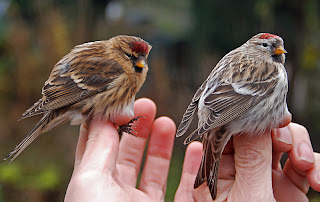This morning (after the many millimeters of rain in the early morning) I went with Tim to ring some nestlings. We checked a few nestboxes of
Great Tits of which I knew the pulli would be old enough to ring. The result was 22 Great Tits, not bad for just a few nests. One nest contained 10 chicks, pretty nice. Further birds of note that we observed were
2 singing
Wood Warblers, 2 singing
Firecrests and
a female
Goshawk.
Great Tit (Parus major), pulli of 7 days old.
Nest of Great Tit with 10 pulli inside.
In the afternoon I went to Zuidbroek, a new neighbourhood/business area with some waste land. The area can be quite nice sometimes with some migrants around. There were quite a few pairs of
Lapwings around, but there was no sign of any
Little Ringed Plovers, which really suprised me since I've always seen at least 3 pairs around here, too bad.. Last year there was also a pair of Redshanks, but I haven't seen any of those here yet.
Lapwing (Vanellus vanellus)
First migrant I had was a male
Wheatear, Zuidbroek is always a good place to see them during migration. A little bit later I had
3 more on a cropfield on the northern side of Zuidbroek. At some sand hopes there were at least
8 Sand Martins present. They had made nests already in a steep sand heap.
Sand Martins (Riparia riparia)
The best birds were
two singing Icterine Warblers, one showed itself pretty well. Getting good views on those is pretty hard, let alone taking photos. I managed to get a proper shot of one of them though. Here I also had my first singing
Garden Warbler of the year.
Icterine Warbler (Hippolais icterina)
As always, there was a pair of
Kestrels and
Buzzards present.










































